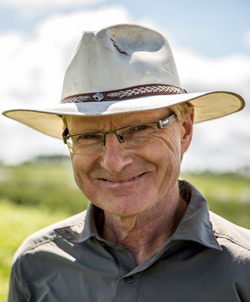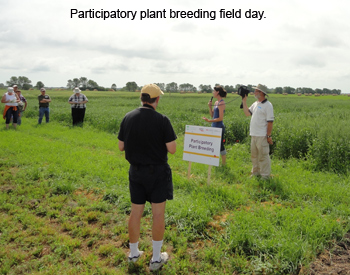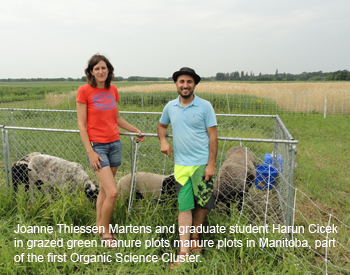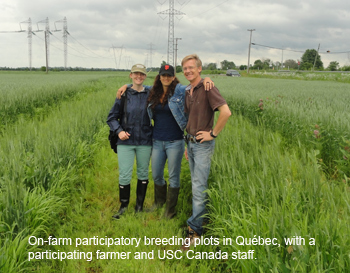The People Behind the Research
A Conversation with Dr. Martin Entz
University of Manitoba
Ìý
Activity A.1: Participatory plant breeding and seed production approaches for Canadian organic crop production
Ìý
Activity A.6: Restoring yield productivity and C sequestration in organic farming systems on the Prairies: The role of composted manure in long-term studies
 |
Industry Partners:
|
Collaborating Researchers (Activity A.1):
|
Can you tell us a bit about yourself?
I am a first generation Canadian. My family came from Germany in the 1950’s and started agricultural activities here in Canada, in Manitoba. The farming philosophies that my European family brought to this country were all about diversity, animal integration, and things that work well in organic farming, which are very in-tune with what I am doing now. I’ve always loved the land, and I am one of those lucky people who fell into being able to do what I really love to do.
You are leading two Research Activities in Organic Science Cluster II (OSCII) - can you briefly explain both?
There are two projects that I have the privilege of being involved in in this Science Cluster.
The first project [Activity A.6] is looking at the soils in our long term Glenlea plots. The , located 20 km south of Winnipeg, compare organic and conventional farming systems over the long term, and we are now entering the 24th year of this study. Organic Science Cluster II is supporting an investigation of how to keep organic soils productive in the long term. The good news: there are ways of doing so that involve a good crop rotation and the recycling of nutrients from animal agriculture back into the farming system. As well, as a part of this study, we are also doing the same type of work on a number of organic farms.
The second project [Activity A.1] involves a different wrinkle, this one to the organic breeding programs that have been going on in Canada. There has been breeding of wheat, oat, corn and potato specifically for organic farming, to make varieties that are suited to the unique circumstances of organically managed soils and organic farming systems. What we have done is taken that to the next level, where we don’t only have the scientists doing the plant breeding, we also have farmers involved in making the selections of the really early generation genetic material.
The participatory breeding project also involves partners, like Agriculture and Agri-Food Canada and farm groups in Québec and in British Columbia, and our university, the University of Manitoba. We make crosses using parental material that farmers are interested in, and then we give the farmers those seeds, usually about 5000 seeds per cross, and they grow them and make selections on their farms. That is a very exciting new direction for plant breeding in Canada. The farmers really like working together with the scientists. We are already seeing, as this project was started a number of years ago, that three generations of selections on organic farms by farmers themselves does have a significant effect in adapting that variety to their place. So that is quite exciting!
What brought you to this research, and what excites you the most about these projects?
For me, there are really two types of excitement. One is the joy of discovery and just seeing what is possible, how things are going in the research, where trends are taking us, looking for unexpected observations. That is always a lot of fun. The second thing is that I consider myself a people person. When you provide people with solutions to their problems on their long term organic farms, or if you engage them directly in being part of the research innovation through plant breeding, you get a lot of satisfaction out of that.
You were also involved in the first Organic Science Cluster. Can you briefly explain your projects and their outcomes? Have your current Research Activities developed as a result of the first Organic Science Cluster?
The first Cluster did provide some support for organic plant breeding, and one of my projects is definitely a continuation of that. The fun thing was that the colleagues who collaborated on that project in wheat and oats both registered a variety or two out of that system. The first Cluster really showed us the potential of being able to adapt varieties to organic soils, a question that many people had been asking themselves. This new work really builds on that.
The other Organic Science Cluster project that I led last go around was looking at reducing tillage in organic crop production. That was an exciting time, with two PhD and two Master’s students working on the project. Reduced tillage in an organic cropping system in this region was an unexplored area, and we really didn’t know what was possible in the dryland Prairies. Thanks to the students and the funding, we made a lot of progress in understanding. We developed some machinery, and we developed some combinations between cover crops and different machine settings, and all of those really subtle things. So now, when we look at the Glenlea project in Organic Science Cluster II, where we’re trying to make organic farming systems sustainable in the long term, say a 30-50 year timeframe, we now have better tools in the form of eliminating a significant amount of tillage from the organic system.
Where are your projects taking place?
In short, they are taking place at our long term study site at Glenlea and on organic farms across the country. We also have a little bit of work at what we call our in Carman, Manitoba.
The farms that we’re working on for the participatory plant breeding are spread from Prince Edward Island all the way to Vancouver Island. In 2014, we worked with 44 farms right across the country, in almost every province – with the exception of Newfoundland and the Territories. That is a logistical challenge, but we have a good team here to keep that all straight, and we are tying in to some regional coordinators with different NGOs to help us coordinate the project.
How do you envision that your research will help organic producers in Canada?
Organic producers have been asking for a long time how to keep soils productive and how to deal with pests, mainly weeds. We’ve long since focused on those two factors in all of our research. We’re breeding crops that grow in more weedy situations and we’re doing long term work to maintain and enhance soil fertility, so I think we’re addressing farmers’ issues. I think we have a very good partnership in Canada between the organic farmers and the community that helps to serve them with information and innovation.
We have scientists now who are able to really explain farming systems back to the farmer. Producers are seeing certain interactions happening in their farming systems, and they’re wondering why things are happening. For instance, farmers may wonder why they are able to grow good crops even though soluble phosphorus levels are very, very low in the soil, so a typical agronomist will would suggest that they have a crisis on their hands. The soil microbiologists who work with us, and with others, are telling us that these systems remain productive because the soil biology has changed to increase the number of beneficial fungi. In that way, I think that is just as important as giving farmers a prescription of how to reduce your tillage or how to add compost to your soil. Farmers have worked out some steps themselves, but they feel a lot more confident about those steps when they know why they’re actually working.
How have the organic community and your industry partners helped to shape your research?
The organic producers have had a profound effect on the direction of research. We have, as a collective national group of organic agriculture researchers, surveyed them quite heavily to try to find out what are their limiting circumstances. That strategic approach has really paid off, and we continue to learn more about their problems. And, the industries are informing us about what are the new markets. Those are very, very important signals, because farming is a business. The partnership between the farmers and the industries, and the support for research through OSCII is a pretty good model for a lot of the challenges that we face.
Are there graduate or undergraduate students, or postdoctoral fellows involved in this research?
In my group, I have four graduate students involved in the Organic Science Cluster projects right now, and I have one research associate/postdoctoral researcher involved, as well as two technical staff which are contributed by the University of Manitoba.
With OSCII, graduate students who used to work in isolation at their own universities now are, in some cases, having advisors from different universities.Ìý We’re all very pleased to work together, to have a community.
To create critical mass, we need each other, and the Organic Science Clusters have helped to facilitate that, and allow us to leverage a lot of things because we work together. There are always provincial and local initiatives, which are important and need to be sustained for local problems, but the fact that Canada has taken this nationwide initiative, and we’ve had people take on the challenge of managing that collective initiative, that allows us to punch above our weight and it allows us to get more value for the research money as well.
For more information on Martin Entz’s work in OSCII, please visit the Activity A.1 and Activity A.6 pages at http://www.dal.ca/oacc. A print-friendly version of this article is available [PDF - 572 kB].
The Organic Science Cluster II (OSCII) project described in this article is supported by the of 's and industry partners. OSCII and this article are collaborative initiatives of the Organic Agriculture Centre of Canada at and the .



